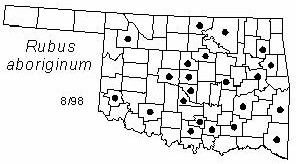Prostrate, scrambling vine which often roots at the tips. Twigs terete, pilose when young, becoming glabrous in second year; prickles scattered, hooked with broad bases, about 3 mm (1/8 in) long. Leaves alternate, palmately compound, 5-foliate on young but 3-foliate on older primocanes; leaflets ovate, oval or elliptic, 7-9 cm (2.8-3.5 in) long; pubescent on both leaflet surfaces; subcordate at base; margins doubly-serrate; rachis and petioles with many spines, sparsely pubescent. Inflorescence a cyme of few flowers, pubescent and lightly armed; flowers 1-4, 2-2.5 cm (0.8-1 in) in diameter; calyx small, 5-lobed, and reflexed; petals 5, white, obtuse; pistils many, inserted on hypanthium; stamens numerous; flowers appear in April. Fruit an aggregation of drupelets, about 15 mm (0.6 in) in diameter, globose, black; numerous; fruits mature in June.
Distribution: Oklahoma, Missouri, and Kansas. Uncommon in Oklahoma.
Habitat: old-fields, prairies, rocky, open woodlands.
Comment: Rubus is a Roman name meaning red; aboriginum means ancestor, probably named from an early collection.
Field identification: Aboriginal dewberry is very closely related to northern dewberry R. flagellaris. Rubus is a complex genus. Species are difficult to identify due to frequent hybridization and introgression.
Food uses: fruits are eaten raw or used in jams, jellies, and sauces.
Wildlife benefits: dewberry fruits are eaten by many species of birds and mammals.
NWI status: none
Distribution in Oklahoma: 
BACK
NEXT
RETURN TO INDEX
Last update: 9/17/99
 Go to Oklahoma Biological Survey Home Page
Go to Oklahoma Biological Survey Home Page
 Disclaimer
Disclaimer